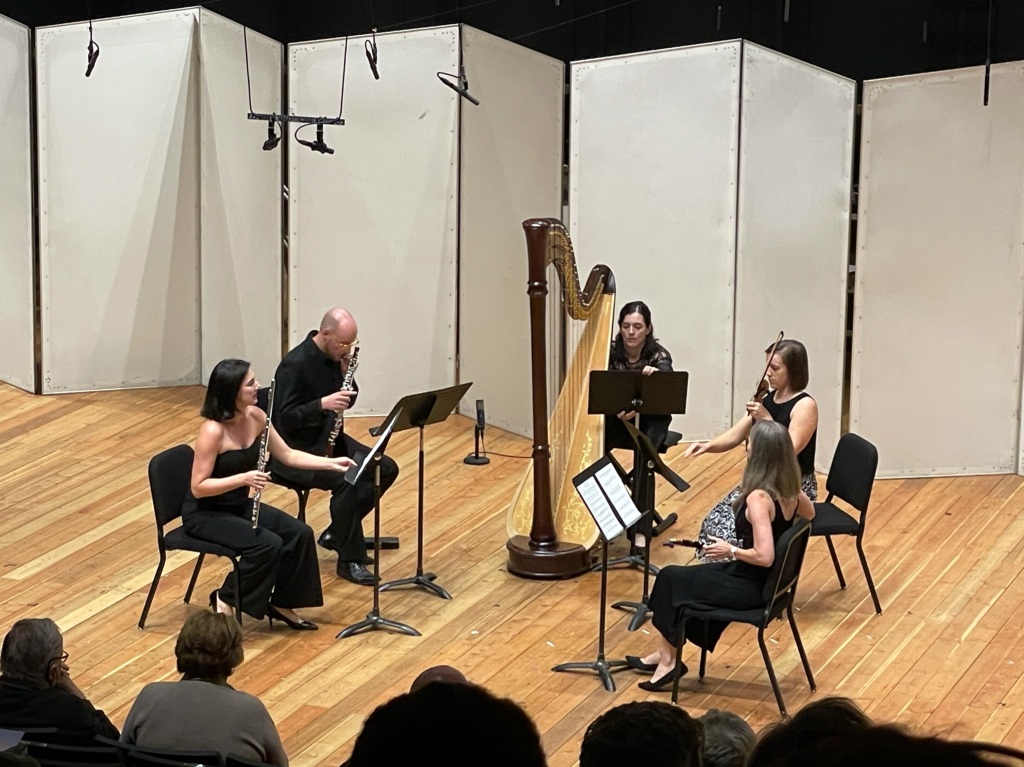
It’s only my first time in these parts, but already I can understand the deep, magnetic sense of connection that draws people back here again and again. Upon passing through the elk antler arch at Jackson Hole Airport (the only U.S. airport located within a national park, incidentally), I soon began to feel the charm of a place that hasn’t been flattened out by plastic predictability. Even with lingering smoke from the latest Western fires imposing a thin pall, the capacity for this landscape to inspire awe was undimmed.
With its marriage of valley and dramatic, looming scarps, it’s obvious how the Jackson Hole area beckoned as an ideal spot to make music. The Grand Teton Music Festival opened on 2 July, following the all-too-familiar hiatus, and is now into Week 4 of a seven-week season — which also marks the Festival’s 60th anniversary.
Last night I began with the first of the week’s offerings, a chamber music evening at Walk Hall, GTMF’s home performance space. It was decently attended, taking into account the reduced-capacity seating plan and a sudden shift in mask policy. (Just last night, in the wake of the new CDC announcement, the official recommendation switched to suggesting that vaccinated and unvaccinated people both wear masks indoors.)
Part of a series curated — and engagingly introduced by — Adelle Eslinger Runnicles, the concert presented a flavorful sampling of periods and instrumental formations, starting with a transcription by Phil Brink for low brass of J.S. Bach’s D minor Chaconne from the Partita No. 2 for solo violin (Michael Mulcahy, trombone; Jared Rodin, trombone; Craig Mulcahy, trombone; Jay Evans, trombone; JáTtik Clark, tuba). The Baroque fondness for transcription aside, Bach’s masterpiece sounded of a different era — not Romantic exactly, but funereal, ritualistic, the opening to new vistas in the later variations remarkably fluid and gentle.
Unmistakably Romantic phrasing beguiled in Saint-Saëns’s Fantaisie for Violin and Harp, Op. 124, featuring
Eunice Keem on violin and Elisabeth Remy Johnson on harp. Exquisitely balanced and fully engaged in playing off each other, the duo cast a spell throughout this late-period piece’s range of moods.
Johnson also performed in Kimberly Osberg’s Just Another Climb,* joined by colleagues Mercedes Smith on flute, Zach Boeding on oboe, Marci Gurnow on clarinet, and Madeline Sharp on viola. If the Saint-Saëns suggested a leisured dreamscape, Just Another Climb packed the punch of an involving musical short story, its impact belying the brevity of the piece’s duration (about four minutes) — and making this a real highlight of the evening.
The young, Portland, Oregon-based Osberg, who was present in the audience, was inspired by the feat of the first “manless” ascent of the Grand Teton made in 1939 by Margaret Bedell, Anne Sharples, Margaret Smith Craighead, and Mary Whittemore — upon which achievement Craighead remarked: ” Craighead wrote: “This may have been of importance to the record of events, but to us it was just another climb.”
This first performance before a live audience emphasized Osberg’s colorfully individualistic writing for each component of the ensemble. The result was an assuredly paced musical storytelling that found freshness in a diatonic idiom, using evocative gestures to hint at but not dictate a plausible narrative. I’m eager to learn more about this composer and hear what she can accomplish with a longer form.
The program’s brass theme sets the stage for the main new work on this week’s orchestral concert, Five Hallucinations for Trombone and Orchestra by Carl Vines. It returned in John Stevens’s Triangles for horn (Josh Phillips), trombone (Jay Evans), and tuba (JáTtik Clark), a piece from 1978 that (not always convincingly) juggles with jazz vernacular.
Concluding the program was a rendition of Beethoven’s C minor String Trio from the Op. 9 set by violinist Louise Morrison, violist Chiara Kingsley Dieguez, and cellist Thomas Carpenter that reveled in the tension between the first movement’s ominous energies and the halcyon release of the Adagio. The long time away from live performance could be sensed in some issues of balance and phrasing, but the richness of this score — Beethoven declared these trios among his finest compositions of the period — came through, most notably in the spidery enigma of the concluding measures.
–(c) 2021 Thomas May All rights reserved
*
Filed under: Grand Teton Music Festival, music news
